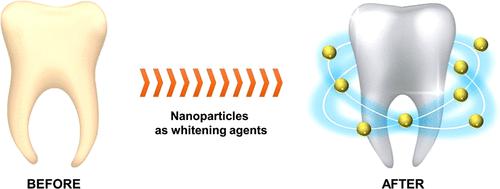Our official English website, www.x-mol.net, welcomes your feedback! (Note: you will need to create a separate account there.)
Nanoparticles as Next-Generation Tooth-Whitening Agents: Progress and Perspectives
ACS Nano ( IF 17.1 ) Pub Date : 2022-06-15 , DOI: 10.1021/acsnano.2c01412 Dai-Hwan Kim 1 , Jina Bae 1 , Jun Hyuk Heo 1, 2 , Cheol Hyun Park 1 , Eun Bi Kim 1 , Jung Heon Lee 1, 2, 3, 4
ACS Nano ( IF 17.1 ) Pub Date : 2022-06-15 , DOI: 10.1021/acsnano.2c01412 Dai-Hwan Kim 1 , Jina Bae 1 , Jun Hyuk Heo 1, 2 , Cheol Hyun Park 1 , Eun Bi Kim 1 , Jung Heon Lee 1, 2, 3, 4
Affiliation

|
Whitening agents, such as hydrogen peroxide and carbamide peroxide, are currently used in clinical applications for dental esthetic and dental care. However, the free radicals generated by whitening agents cause pathological damage; therefore, their safety issues remain controversial. Furthermore, whitening agents are known to be unstable and short-lived. Since 2001, nanoparticles (NPs) have been researched for use in tooth whitening. Importantly, nanoparticles not only function as abrasives but also release reactive oxygen species and help remineralization. This review outlines the historical development of several NPs based on their whitening effects and side effects. NPs can be categorized into metals or metal oxides, ceramic particles, graphene oxide, and piezoelectric particles. Moreover, the status quo and future prospects are discussed, and recent progress in the development of NPs and their applications in various fields requiring tooth whitening is examined. This review promotes the research and development of next-generation NPs for use in tooth whitening.
中文翻译:

纳米颗粒作为下一代牙齿美白剂:进展与展望
美白剂,例如过氧化氢和过氧化脲,目前用于牙科美容和牙科护理的临床应用。然而,美白剂产生的自由基会造成病理损伤;因此,它们的安全问题仍然存在争议。此外,已知增白剂不稳定且寿命短。自 2001 年以来,纳米粒子 (NPs) 已被研究用于牙齿美白。重要的是,纳米粒子不仅起到研磨剂的作用,还能释放活性氧并帮助再矿化。这篇综述根据其美白效果和副作用概述了几种 NP 的历史发展。纳米颗粒可分为金属或金属氧化物、陶瓷颗粒、氧化石墨烯和压电颗粒。此外,还讨论了现状和未来前景,研究了 NP 的开发及其在需要牙齿美白的各个领域中的应用的最新进展。这篇综述促进了用于牙齿美白的下一代 NP 的研究和开发。
更新日期:2022-06-15
中文翻译:

纳米颗粒作为下一代牙齿美白剂:进展与展望
美白剂,例如过氧化氢和过氧化脲,目前用于牙科美容和牙科护理的临床应用。然而,美白剂产生的自由基会造成病理损伤;因此,它们的安全问题仍然存在争议。此外,已知增白剂不稳定且寿命短。自 2001 年以来,纳米粒子 (NPs) 已被研究用于牙齿美白。重要的是,纳米粒子不仅起到研磨剂的作用,还能释放活性氧并帮助再矿化。这篇综述根据其美白效果和副作用概述了几种 NP 的历史发展。纳米颗粒可分为金属或金属氧化物、陶瓷颗粒、氧化石墨烯和压电颗粒。此外,还讨论了现状和未来前景,研究了 NP 的开发及其在需要牙齿美白的各个领域中的应用的最新进展。这篇综述促进了用于牙齿美白的下一代 NP 的研究和开发。


























 京公网安备 11010802027423号
京公网安备 11010802027423号